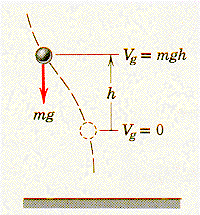| |
When
an object moves on or near the earth's surface it experiences a force due to
the gravitational interaction with the earth. This gravitational force has the
special property that the total work it does as the object moves between two
positions is independent of the path taken between these positions. Forces
of this type are said to be "conservative." The work done by the
gravitational force as an object is moved through a height, h, along an arbitrary
path is mgh, where g is the "acceleration" due to gravity, DVg = mgh.
In general, it is only the change
in gravitational potential that is of interest and setting
Vg
= 0
at the lowest point of interest gives the potential at a location, h,: Vg
= mgh where
Vg is said to be the "Potential Energy" of the object
at this location.
|
|
|
|
|
|
|
|
|
|
|
|
| |
Combining
this change in potential energy with the previously considered change in
kinetic energy due to the action of a non-conservative force on the body gives
an expression for the Work-Energy equation: U = D(Kinetic
Energy) + D(Potential Energy).
If only conservative forces act on the body, U = 0, and the change in
the kinetic energy is equal in magnitude and opposite in sign to the change
in the potential energy. For this case, total energy is conserved as it converts
from one form to the other. This is a useful concept since the change in
potential energy is path independent and permits easy computation of the path
dependent kinetic energy change.
|
|
